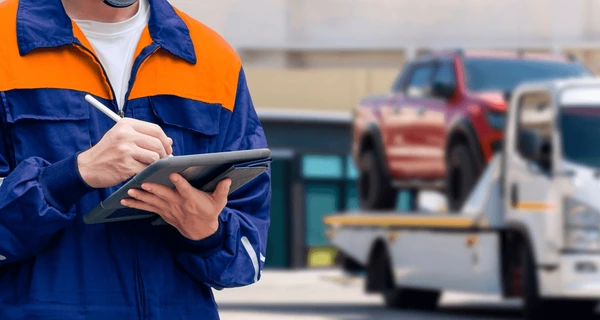
Vehicles should be properly prepared to avoid damage during towing, whether it’s a non-functional car or one that just needs relocating.A poorly prepared vehicle can suffer minor to major damages during transportation resulting in costing you time and money. This guide illustrates setp-by-step procedure on how to prepare your car for towing in the safest manner possible with the least hassle for complete peace of mind.
1. Understand the Type of Towing Needed
Find out what kind of towing services a provider offers before you even begin thinking of preparing your vehicle for towing. Some providers will pigeonhole you into specific types so you are forced to encounter expensive add-ons. These categories include:
Please keep in mind that this is not a comprehensive list.
- Flatbed Towing – A type of towing most preferred that protects a car and places it on top of a flatbed truck for towing.
- Dolly Towing – Maintains the back wheels of a towing car on the road while the front ones are lifted and pulled on a tow dolly.
- Tow Bar Towing – Requires attaching a towed vehicle to another one and pulling it over long distances.
- Wheel Lift Towing – Putting a mechanical lift under the tow car to grab and hold two front wheels while the two rear wheels touch the ground.
2. Check Your Owner’s Manual
Considering the vast amount of vehicle models available, each comes with its own user manual that explains in detail how the device can and should be used. Look for any towing pointers that provide precautionary suggestions such as where neutral should be, positioning of towing hooks, backbone of the vehicle and how much weight can be pulled without supplied or rendered any form of service. If a vehicle has instructions from the manufacturer, it is blindly recommended that one follows them to avoid damaging a drivetrain and guaranteeing safe towing.
3. Remove Personal Belongings
Prior to towing, make sure to take out all valuables, loose items that can cause damage, or any fragile belongings that can break. During transport, a lot of items tend to shift which can cause damage. Items that need to be removed include:
✅ Electronics (phones, chargers, tablets)
✅ Documents (registration and insurance papers)
✅ Loose items (water bottles, sunglasses, tools)
4. Secure Windows, Doors, and Sunroof
Make sure windows and doors are closed securely and properly. If your vehicle has a sun roof, do remember that it is closed so dust and other debris do not get into the vehicle.
5. Inspect and Secure Tires
Tires that are properly inflated aid in balance and stability of the verhicle when towing. Make sure that there is adequate amount of air in the tires. Check that there are no leaks or punctures as these worsen the situation. Weakened tires can place excess burden during transport.
6. Disengage the Parking Brake
Should your car be towed using a dolly, or put on suspension lift, disengage parking brake. This is done in order to prevent damage to the transmission system or the break system. While, when the car is moved on a flatbed, the parking brake can kept on.
7. Shift to Neutral Gear
For automatic vehicles, putting the transmission neutral (n) takes stress off the drive train. This should also done for manual vehicles with the clutch not engaged. Putting the vehicle in this position avoids damaging the transmission placed during towing.
8. Disconnect the Battery (If Needed)
It is useful to remove the battery when towing a vehicle over long distances. This avoids possible problems related to the depletion of battery power or other electrical complications.
9. Use Tow Hooks or Attachments
Many vehicles today have pre-fitted towing hooks. Find these hooks and securely fit the towing rope or chain. If your vehicle lacks specific towing hooks, please check the manual or call a professional towing service to guide you on the correct spots.
Read More: When to Call a Towing Operator
10. Turn On Hazard Lights
Activating hazard lights enhances safety and informs motorists that your car is in the process of being towed. Apply caution while warning signs should displayed instead if the vehicle’s battery is disconnected.
11. Communicate with the Towing Operator
Speak to the tow truck driver about unique details before beginning the towing process. If the vehicle has unique criteria for operation, like special requirements for all wheel drive vehicles, such as AWD or Hybrid -Specific towing, notify the operator.
12. Verify the Tow Truck’s Credentials
To tow with safety in mind, you need to make sure the company is:
✔ Licensed and has Insurance
✔ Has the correct towing equipment
✔ Has experienced about vehicle.
13. Check for Damage Before and After Towing
Make sure that your vehicle is photographed from all sides before the tow for damage documentation. When the vehicle is delivered, check for tampering and damage and raise any issues right away.
Conclusion
Preparing your car for towing ahead of time is crucial so that it gets towed correctly and without damages. By following this step-by-step guide on how to prepare your car for towing, will help you avoid vehicle damage and other issues. Regardless of whether it’s a breakdown or moving an automobile, these tips will highlight circumstances that require your attention to ensure everything goes smoothly.
If you require assistance with towing, contact a reliable towing service in your area right away!